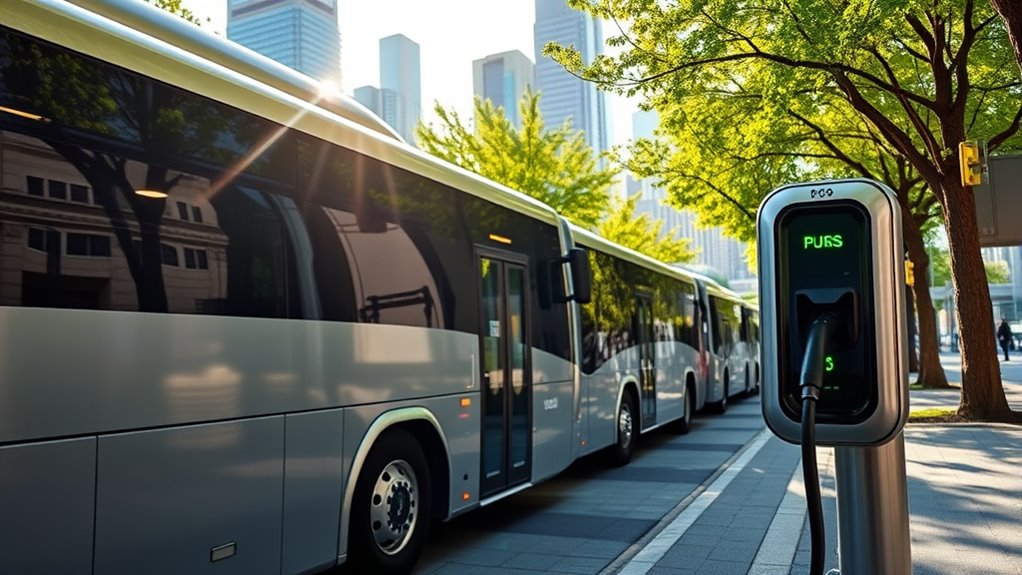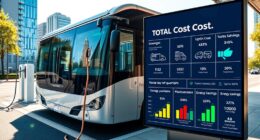Switching to electric buses can save you significant money over time by reducing fuel and maintenance costs—often around $400,000 over their lifespan—and cutting emissions that improve air quality and health. Energy efficiency and incentives further boost savings, while lower upkeep means less downtime and repairs. These benefits not only help your budget but also support a cleaner, quieter community. Keep exploring to discover how these long-term advantages can transform your transit system.
Key Takeaways
- Electric buses significantly reduce fuel and maintenance costs, leading to approximately $400,000 in savings over their lifespan.
- Long-term investment recovery occurs within about five years, with ongoing annual savings around $50,000 per bus.
- Lower energy and maintenance expenses improve financial stability and predictability over time.
- Incentive programs and emerging technologies like V2G enhance revenue streams and offset initial costs.
- Reduced emissions and noise contribute to healthier communities, translating into economic and social savings.

Switching to electric buses can lead to significant long-term savings, even though the initial investment is higher. While the upfront cost of electric buses is greater, the savings you’ll see over their lifespan make the switch worthwhile. According to New Flyer data, each electric bus can save around $400,000 in fuel and maintenance costs throughout its operational life.
Electric buses offer substantial long-term savings despite higher upfront costs.
Similarly, Proterra estimates that you can recover your investment in about five years, thanks to approximately $50,000 annual savings in fuel and maintenance. Plus, state and federal incentives, like New York’s $500 million Environmental Bond Act, can help offset the initial purchase costs, making the transition more affordable upfront.
Fuel costs are a major driver of these savings. Electric drivetrains are highly energy-efficient, minimizing energy waste during operation. Unlike diesel-powered buses, electric models depend on electricity, which has more predictable prices and isn’t subject to the volatility of fossil fuel markets. This stability allows for more accurate long-term budgeting.
Additionally, electric buses produce no tailpipe emissions, contributing to climate benefits valued at roughly $40,400 per bus, according to 2017 studies. Regenerative braking technology further enhances energy efficiency by capturing energy during stops, reducing overall electricity consumption.
Maintenance savings are another significant advantage. Electric buses have fewer moving parts—no exhaust systems or transmissions—meaning they’re less prone to mechanical failures. NYSERDA data indicates that each bus can save over $10,000 annually in maintenance costs. Modern electric buses also incorporate advanced battery technology, which improves durability and performance over time.
They don’t require oil changes or fluid checks, and their brakes last longer thanks to regenerative braking, which reduces pad wear. Diagnostic software allows for proactive maintenance, catching issues early and avoiding costly repairs. These factors combine to lower lifetime repair costs and reduce service disruptions, keeping buses on the road longer and more reliably. Furthermore, ongoing advancements in battery efficiency continue to improve operational performance and reduce costs.
Beyond cost savings, electric buses deliver health and environmental benefits that translate into economic gains. Studies from 2017 to 2024 show a total savings of about $84,200 per bus, factoring in health improvements and climate impacts.
Zero tailpipe emissions improve air quality, especially near schools and busy routes, reducing respiratory issues like asthma. Quieter operation reduces noise pollution, enhancing community well-being. These improvements also support climate resilience by decarbonizing transportation networks. Furthermore, the reduced noise pollution contributes to improved urban livability, benefitting the surrounding communities.
Funding opportunities further ease the transition. Grants from programs like NYSERDA, the federal Clean School Bus Program, and utility rebates can cover significant portions of costs, including charging infrastructure. Some districts explore vehicle-to-grid (V2G) systems, generating revenue by selling stored energy back to the grid.
Municipal bonds backed by projected savings offer additional financing options. Combining these funding sources, districts can maximize their investments and accelerate adoption.
Operational efficiencies also contribute to long-term savings. Electric buses use less energy when idling, accelerate faster, and feature remote diagnostics that minimize downtime. Maintenance becomes simpler with fewer parts and streamlined training, extending vehicle lifespan. Enhanced battery management systems further optimize energy use and longevity.
These efficiencies improve route times, reduce fuel expenses, and make fleet management more predictable. As technology advances, the reliability and cost-effectiveness of electric buses continue to improve, making them an increasingly attractive option for transit agencies.
Finally, transitioning to electric buses stimulates economic growth through job creation in manufacturing, maintenance, and infrastructure development. It shifts local energy spending from imported fuel to domestic electricity, bolsters health outcomes, and positions districts as leaders in green technology.
The long-term financial and societal benefits make the switch to electric buses a smart, sustainable choice for your community.
Frequently Asked Questions
What Are the Initial Costs of Electric Bus Infrastructure?
You’ll face initial costs for electric bus infrastructure, including $10,000 to $30,000 per bus for charging equipment and electrical upgrades.
If you need site-specific improvements like new power lines or transformers, expenses can rise considerably, especially with distant lots or regional utility rates.
Planning ahead and seeking grants can help manage these costs, but expect substantial upfront investments to make sure your charging stations are ready for operation.
How Does Battery Recycling Impact Environmental Savings?
Battery recycling considerably boosts environmental savings by conserving raw materials like lithium and cobalt, which reduces habitat destruction and water contamination. It prevents batteries from ending up in landfills, lowering pollution and fire risks.
Recycling creates a closed-loop system, minimizing waste and greenhouse gases. Plus, it supports reuse and refurbishing, extending battery life, and promotes sustainable practices, helping you reduce your overall environmental footprint while fostering a cleaner, greener future.
Are Electric Buses Suitable for Long-Distance Routes?
You might wonder if electric buses suit long-distance routes. The good news is, many models now reach up to 300 miles on a single charge, covering most routes easily.
Advances in battery tech, efficient driving, and proper infrastructure make them viable for longer trips.
As long as you plan for charging stops and consider environmental factors, electric buses can reliably serve long-distance routes, offering cleaner and cost-effective transportation.
What Training Is Required for Maintenance Staff?
Think of it like training to become a skilled navigator on a new voyage. You’ll need to learn high voltage safety protocols, battery system maintenance, and electric propulsion diagnostics.
Hands-on workshops, manufacturer certifications, and annual updates keep you sharp. You must also master safety standards like NFPA 70E and incident reporting.
Cross-training across disciplines and stakeholder collaboration guarantee you’re fully prepared to keep electric buses running smoothly and safely.
How Do Electric Buses Affect Passenger Comfort and Safety?
You’ll notice that electric buses greatly improve passenger comfort and safety. They offer spacious, quiet interiors with better climate control, ensuring a smooth, enjoyable ride.
Safety features like advanced collision avoidance systems help protect passengers, while eco-friendly operation reduces noise and air pollution. This combination of comfort and safety encourages more people to choose public transport, making your transit experience more pleasant and secure.
Conclusion
Switching to electric buses isn’t just about saving money; it’s about investing in a cleaner, more sustainable future. Think of it like planting a tree—you may not see the full shade right away, but over time, the benefits grow exponentially. With initial costs decreasing and maintenance savings rising, you’re building a legacy of efficiency and environmental responsibility. Embrace the change now, and watch your community thrive, just like a well-tended tree providing shelter for years to come.









